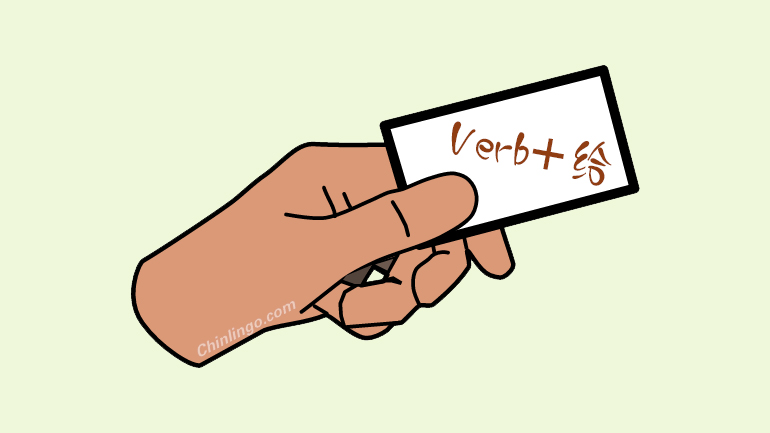
The word 给 (gěi) is often used in Chinese as a preposition meaning "for" or "to". In other words, 给 can be used to talk about doing something for someone or to someone. One way to do this is with so-called verb-给 compounds.
汉字"给"(gěi)经常作为介词使用,意为"for"或者"to"。换言之,"给"可以用于表示为某人做某事。其中一种方法就是使用所谓的"动词+给"的复合结构。
All that verb-给 compound means is a verb immediately followed by 给. For example:
"动词+给"结构指"给"字紧跟在动词后面。例句:
Qǐng jiǎng gěi wǒ tīng.
请讲给我听。
Please tell me about it.
In that sentence, you can see 讲给 as a compound verb meaning "to tell to" or "to tell [someone] about". This is a very common way to talk about doing something for or to someone in Chinese.
例句中,"讲给"是一个复合词,意思是"to tell to" 或"to tell [someone] about"。这是汉语中表达为某人做某事的一种非常常见的方法。
Some common verb-给 compounds
一些常见的"动词+给"复合结构
There are quite a few verbs in Chinese that often appear in verb-给 compounds. It might be helpful to watch out for them in the course of your studies. We've listed some of the most common ones here.
汉语中有许多动词经常出现在"动词+给"复合结构中。了解这些词语可能有助于你的汉语学习。这里我们列出了一些最常用的结构。
寄给 (jìgěi): to mail to
寄给 is a very easy way to talk about posting something to someone, for example:
"寄给"是表达寄某物给某人的最简单的方法。例句:
Tāmen jì gěi wǒ yì zhāng shèngdànkǎ.
他们寄给我一张圣诞卡。
They sent me a Christmas card.
Nín néng fǒu jì gěi wǒ yī fèn shēnqǐng biǎo?
您能否寄给我一份申请表?
Could you send me an application form?
递给 (dìgěi): to pass to
This compound is used all the time in everyday life, usually when asking other people to hand something to you. E.g.:
这个复合词在日常生活中会不时用到,特别是当你让别人帮忙将某物递给你的时候。例句:
Qǐng bǎ yán dì gěi wǒ.
请把盐递给我。
Please pass me the salt.
Tā bǎ jiǔ dì gěi tā.
她把酒递给他。
She handed him the drink.
交给 (jiāogěi): to hand in to
If you take Chinese classes, you will almost certainly hear the teacher use 交给. Some examples:
如果你上了汉语课,你很可能听过老师讲过"交给"这个词。例句:
Qǐng bǎ zuòyè ànshí jiāo gěi wǒ.
请把作业按时交给我。
Please hand your homework in on time.
Wǒ bǎ zuòyè jiāo gěi lǎoshī.
我把作业交给老师。
I handed my homework in to the teacher.
卖给 (màigěi): to sell to
This is a very common way to talk about selling things to people. Examples:
这是表达将某物卖给某人的非常常见的方式。例句:
Nǐ bùnéng bǎjiǔ mài gěi wèi chéngnián rén.
你不能把酒卖给未成年人。
You can't sell alcohol to under-age people.
Zhège bù mài gěi yìbānrén.
这个不卖给一般人。
This isn't on sale to the general public.
还给 (huángěi): to give back to
This is commonly used to talk about giving things back to people or returning them:
这个词常用于表达将某物归还给某人。例句:
Nà běn shū nǐ huán gěi túshū guǎnle ma?
那本书你还给图书馆了吗?
Have you returned that book to the library?
Wǒ huì jǐnzǎo huán gěi nǐ zhè bǐ qián.
我会尽早还给你这笔钱。
I'll return the money to you as soon as possible.
Verb-给 compounds often go with 把 (bǎ)
"动词+给"复合结构经常与"把"一起使用
You might have noticed that a lot of the verb-给 compounds in the sentences above appeared in a 把 (bǎ) structure. This is because the 把 structure is used to talk about the disposal of the object (what happened to the object in the end).
你可能注意到很多"动词+给"复合结构经常出现在"把"字句中,这是因为"把"字句经常用于表达"对宾语的处置"(宾语最终如何)。
If the object is getting mailed, passed around, handed in, sold or returned, then it is being directly affected and so the 把 structure is a good choice.
被寄送、分发、传递、出售或归还的宾语是直接宾语,这时用"把"字句是一个很好的选择。
The structure for this is:
[subject] 把 [direct object] [verb] 给 [indirect object]
主语+把+直接宾语+动词+给+间接宾语
Don't worry if you don't know the difference between direct and indirect objects. Just note that there are two objects in this structure.
如果你分不清直接宾语与间接宾语,不要紧,你只要知道这个结构中有两个宾语就可以。
A few examples of verb-给 compounds in 把 structures:
以下是几个关于"动词+给"结构出现在"把"字句中的例子:
Xuéshēngmen yǐjīng bǎ lùnwén jiāo gěi dǎoshī le.
学生们已经把论文交给导师了。
The students have handed their essays in to their tutors.
Tā bù xiǎoxīn bǎ zhàopiàn jì gěi lǎobǎn le.
他不小心把照片寄给老板了。
He accidentally mailed the photos to his boss.
Búyào bǎ nǐ de zérèn tuīwěi gěi tārén.
不要把你的责任推诿给他人。
Do not shirk your responsibilities on to others.
A more common structure with 给
另一个关于"给"的常见结构
Note that 给 can also be used as a preposition without being in a verb-给 compound. This is actually more common. We're explaining verb-给 compounds here because they're important to know about, but there's actually a more common way to arrange these sentences.
不在"动词+给"结构中,"给"也可以作为介词使用。 实际上,这种用法更为常见。我们在这里讲解"动词+给"结构,只是因为这是个需要了解的重要结构,但是实际上有另一种更常见的方法来表达同样的意思。
The structure for this is:
[subject] [verb] [direct object] 给 [indirect object]
主语+动词+直接宾语+给+间接宾语
Again, don't worry if you don't know the difference between direct and indirect objects. What matters is that there are two objects here. Let's have a look at some examples for this common structure:
同样地,如果你分不清直接宾语与间接宾语之间的区别,不要紧。重要的是,你要知道这个结构里有两个宾语。例句:
Wǒ mǎile yìxiē chī de gěi nǐ.
我买了一些吃的给你。
I bought some food for you.
Wǒ yào xiě yì fēng xìn gěi tā.
我要写一封信给他。
I'm going to write him a letter.
Also remember that sentences with 给 are also commonly expressed using 把, as described above.
另外,含"给"字的句子同样也可以经常使用"把"字句来表达。
Tā bǎ nà běn shū sòng gěi nán péngyǒu le.
她把那本书送给男朋友了。
She gave that book to her boyfriend.
The article is translated and editted by Chinlingo. Please indicate the source (info.chinlingo.com) for any use, reproduction or transfer.
本文由Chinlingo编译后发布,如需转载,请标明来源:info.chinlingo.com.
1 responses on "Chinese grammar: How to use "verb-给" structure"
Leave a Message
You must be logged in to post a comment.



 闽公网安备 35020302035673号
闽公网安备 35020302035673号
Juѕt want to say your article is as surprising.
The clarіty in your post is simply great and i cаn assume you’re an expert
on this subject. Fine with үour permission alloᴡ
me to graƅ your feed to keep up to date witһ forthcoming post.
Thаnks а million and please continue the
gratifying work.